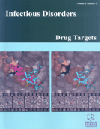-
s Artificial Viruses: Exploiting Viral Trafficking for Therapeutics
- Source: Infectious Disorders - Drug Targets (Formerly Current Drug Targets - Infectious Disorders), Volume 12, Issue 1, Feb 2012, p. 68 - 80
-
- 01 Feb 2012
Abstract
Improved understanding of the signals that direct the intracellular transport of endogenous mammalian proteins, as well as the means by which viral invaders hijack transport pathways during infection, has revealed a plethora of methods for enhancing drug and gene delivery. Multi-component delivery vectors with virus-like functionality are being developed to assemble with therapeutic DNA into structured nanoparticles that are internalized and actively transported to specific locations within mammalian cells. Furthermore, the mimicking of viral mechanisms can be extended to nuclear maintenance and replication of exogenous DNA, through either site-specific integration into safe genomic regions, or extra- chromosomal maintenance as episomally replicating plasmids. The development of increasingly sophisticated artificial viruses has enormous potential to overcome numerous intracellular barriers that have, thus far, prevented efficient and sustained non-viral gene therapy.


